Last updated on November 16th, 2024 at 08:38 am
Expressing gratitude for someone’s concern acknowledges their care and attention.
When someone says “Thanks for your concern,” it’s important to respond in a way that conveys empathy, support, and reassurance.
Here are 30 thoughtful and considerate responses to help you navigate these moments with grace and sincerity.
In our daily interactions, expressing concern for others and being acknowledged for it with “Thanks for your concern” is a common exchange.
However, knowing how to respond thoughtfully can make a significant difference in nurturing relationships and demonstrating genuine empathy.
A well-crafted response can reinforce your support, show you care deeply, and strengthen your connection with the person expressing gratitude.
This article explores 30 thoughtful replies to “Thanks for your concern,” each designed to convey empathy and support while maintaining a conversational tone.
You’re welcome. I’m always here if you need to talk.

Showing your availability and willingness to listen reinforces your support. This response assures the person that they can rely on you whenever they need to share their thoughts or feelings. It’s a simple yet powerful way to express your ongoing commitment to their well-being.
Example:
Person A:
Thanks for your concern.
Person B:
You’re welcome. I’m always here if you need to talk.
By emphasizing your availability, you remind them that your support is not just a one-time offer but a continuous presence in their life.
No problem at all. I’m glad I could help.
This response reassures the person that you were happy to assist them. It downplays any inconvenience on your part and focuses on the positive outcome of your concern.
Example:
Person A:
Thanks for your concern.
Person B:
No problem at all. I’m glad I could help.
By saying “No problem at all,” you make it clear that helping them was a pleasure, reinforcing the idea that their well-being is important to you.
Anytime. Your well-being matters to me.
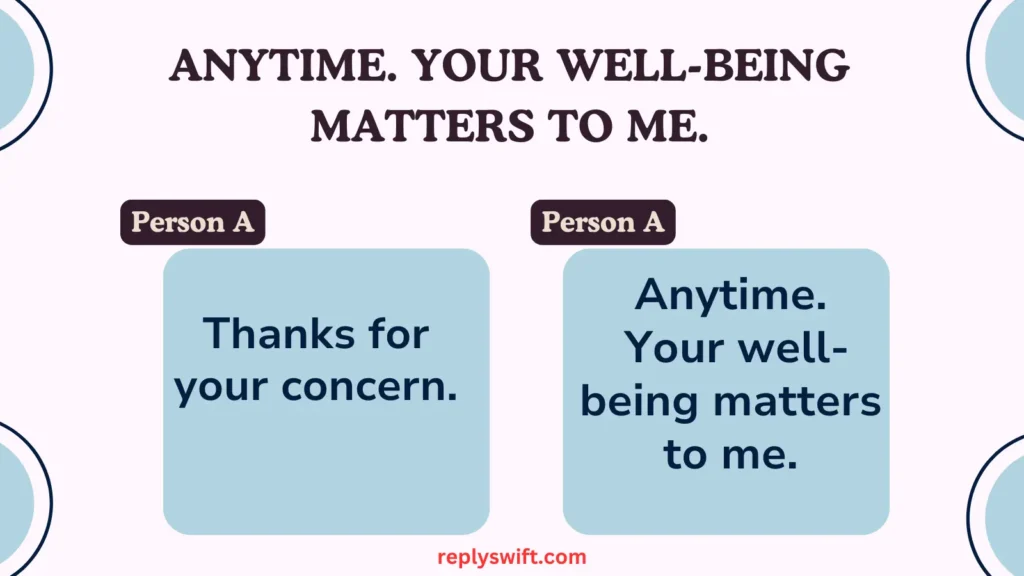
Emphasizing the importance of their well-being shows your genuine concern. This response conveys that their health and happiness are a priority for you, strengthening the emotional bond between you.
Example:
Person A:
Thanks for your concern.
Person B:
Anytime. Your well-being matters to me.
Using the word “anytime” highlights your readiness to offer support whenever needed, reinforcing your commitment to their well-being.
Don’t mention it. I’m just glad you’re okay.

Downplaying your effort while focusing on their well-being adds a touch of humility. This response shifts the attention from your actions to the positive outcome, showing that their safety and health are what truly matter.
Example:
Person A:
Thanks for your concern.
Person B:
Don’t mention it. I’m just glad you’re okay.
This approach reassures them that your concern was genuine and selfless, aiming solely at their betterment.
It was nothing. I’m here for you whenever you need.
Reiterating your availability for future support strengthens your bond. This response conveys that your concern and support are ongoing, not limited to a single instance.
Example:
Person A:
Thanks for your concern.
Person B:
It was nothing. I’m here for you whenever you need.
By stating “It was nothing,” you minimize your effort and highlight your willingness to continue being a source of support.
I’m just glad you’re feeling better.
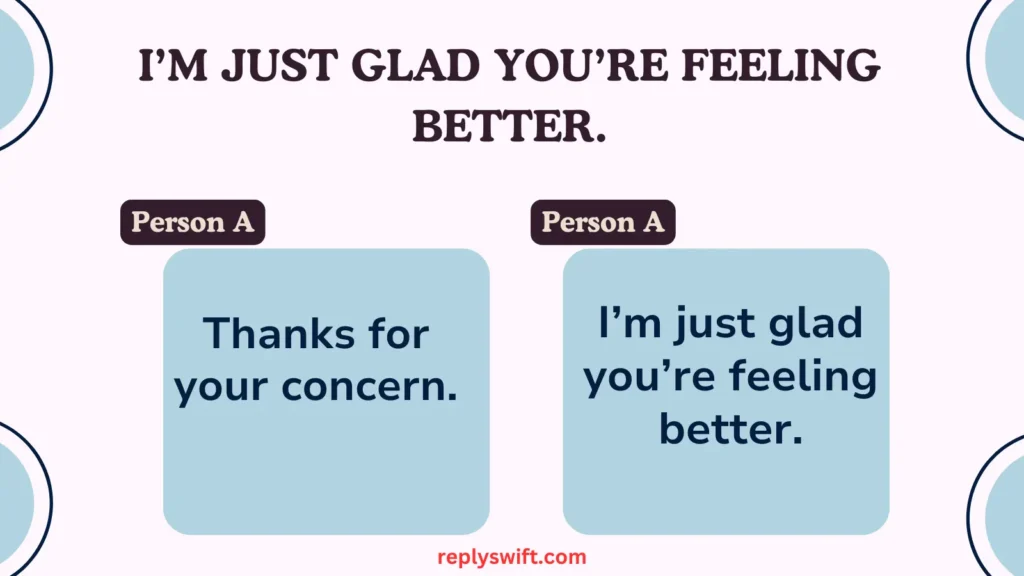
Highlighting your relief at their improvement reinforces your care. This response focuses on the positive change in their condition, showing that their well-being is your primary concern.
Example:
Person A:
Thanks for your concern.
Person B:
I’m just glad you’re feeling better.
This response emphasizes that their recovery or improvement is what truly matters to you.
My pleasure. I care about you and your happiness.

Expressing that it was a pleasure shows your genuine affection and concern. This response conveys that their happiness is important to you and that you’re happy to contribute to it.
Example:
Person A:
Thanks for your concern.
Person B:
My pleasure. I care about you and your happiness.
By saying “My pleasure,” you highlight that helping them brought you joy, reinforcing the depth of your care.
Of course. You’re important to me.
Affirming their importance to you strengthens your connection. This response conveys that your concern is a natural outcome of how much they mean to you.
Example:
Person A:
Thanks for your concern.
Person B:
Of course. You’re important to me.
This statement reassures them that their significance in your life naturally leads to your caring actions.
No worries. I’m here to support you.
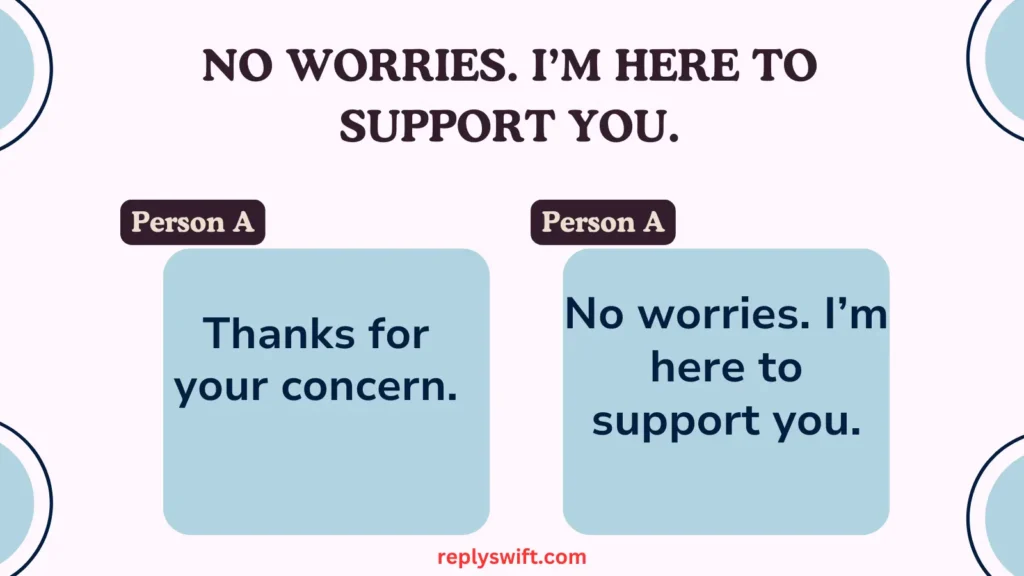
This response offers reassurance and reinforces your role as a supporter. It conveys that they can rely on you without hesitation.
Example:
Person A:
Thanks for your concern.
Person B:
No worries. I’m here to support you.
Using “No worries” implies that providing support is a given, and your primary goal is their well-being.
It’s the least I could do. I hope things are looking up now.
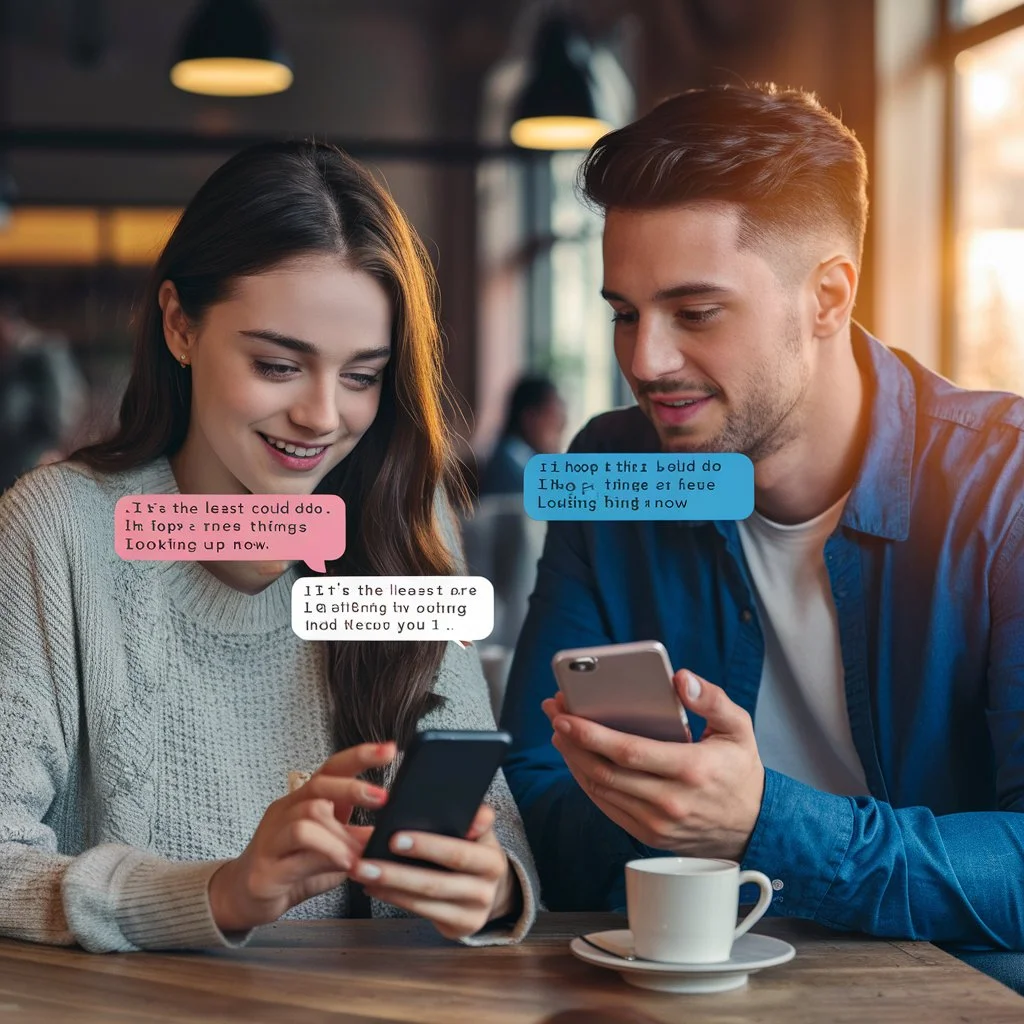
Acknowledging your action as minimal emphasizes your ongoing support. This response conveys humility and hope for their situation to improve.
Example:
Person A:
Thanks for your concern.
Person B:
It’s the least I could do. I hope things are looking up now.
By downplaying your effort, you shift the focus to their situation and express a desire for better outcomes.
I’m just glad I could be there for you.
Expressing your gladness highlights the significance of your support. This response emphasizes your satisfaction in being able to help.
Example:
Person A:
Thanks for your concern.
Person B:
I’m just glad I could be there for you.
This response conveys that being able to support them was meaningful to you, reinforcing your commitment to their well-being.
Always happy to help. How are you feeling now?
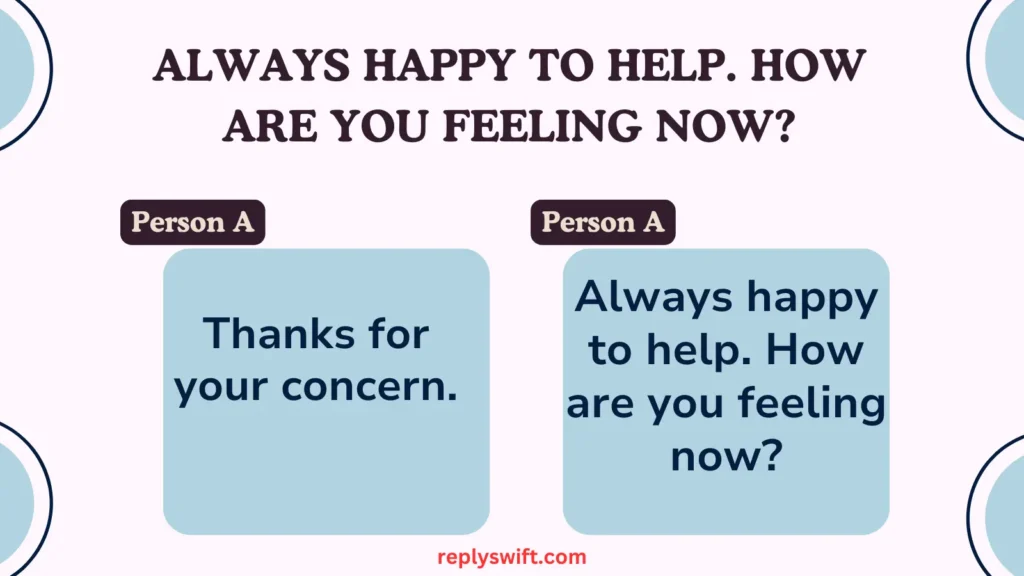
Offering continued help and inquiring about their current state shows ongoing concern. This response combines reassurance with a follow-up question, showing that your concern extends beyond a single interaction.
Example:
Person A:
Thanks for your concern.
Person B:
Always happy to help. How are you feeling now?
By asking about their current state, you show that your concern is continuous and that you genuinely care about their well-being.
You’re very welcome. I hope everything is improving.

This response blends gratitude with a wish for their continued improvement. It conveys your hope for positive changes in their situation.
Example:
Person A:
Thanks for your concern.
Person B:
You’re very welcome. I hope everything is improving.
By expressing hope for improvement, you show that your concern includes a desire for their ongoing well-being.
It’s no trouble at all. Your well-being is my priority.
Emphasizing that it was no trouble underscores your dedication to their well-being. This response conveys that their health and happiness are paramount to you.
Example:
Person A:
Thanks for your concern.
Person B:
It’s no trouble at all. Your well-being is my priority.
By making their well-being a priority, you show that your concern is genuine and selfless.
I’m here for you, anytime. How are you holding up?
Reaffirming your availability and asking about their current state shows ongoing care. This response combines reassurance with a follow-up question, showing that your support is continuous.
Example:
Person A:
Thanks for your concern.
Person B:
I’m here for you, anytime. How are you holding up?
By asking about their current state, you demonstrate ongoing concern and a desire to stay updated on their well-being.
Glad to be of help. I’m here if you need anything else.

Offering further assistance reinforces your supportive role. This response shows that you’re ready to continue providing support as needed.
Example:
Person A:
Thanks for your concern.
Person B:
Glad to be of help. I’m here if you need anything else.
By offering additional assistance, you show that your concern and support are not limited to one instance.
No thanks needed. Just want to make sure you’re okay.
Downplaying the need for thanks while focusing on their well-being shows selflessness. This response emphasizes that your primary concern is their health and happiness.
Example:
Person A:
Thanks for your concern.
Person B:
No thanks needed. Just want to make sure you’re okay.
This approach reinforces that your actions were motivated solely by their well-being.
It’s my duty as a friend. How can I help further?
Framing your concern as a friendly duty highlights your commitment. This response emphasizes the role of friendship in your actions.
Example:
Person A:
Thanks for your concern.
Person B:
It’s my duty as a friend. How can I help further?
By framing your concern as a duty, you show that your actions are rooted in your commitment to their friendship.
Anytime, really. Your peace of mind is important to me.

Emphasizing their peace of mind underscores your genuine concern. This response shows that their mental and emotional well-being is a priority for you.
Example:
Person A:
Thanks for your concern.
Person B:
Anytime, really. Your peace of mind is important to me.
By highlighting the importance of their peace of mind, you convey a deep level of care and support.
Don’t worry about it. I’m glad to support you.

Downplaying the effort while expressing gladness reinforces your supportive nature. This response conveys that helping them was no trouble and that you’re happy to do it.
Example:
Person A:
Thanks for your concern.
Person B:
Don’t worry about it. I’m glad to support you.
This approach reassures them that your support was freely given and not burdensome.
It was my pleasure. I hope you’re feeling better now.
Combining pleasure with a wish for their well-being shows genuine care. This response conveys that you were happy to help and that you hope for their continued improvement.
Example:
Person A:
Thanks for your concern.
Person B:
It was my pleasure. I hope you’re feeling better now.
By expressing pleasure and hope, you reinforce your genuine care and support for them.
Absolutely. Your happiness is worth it.

Highlighting the value of their happiness reinforces your concern. This response shows that their well-being and happiness are important to you.
Example:
Person A:
Thanks for your concern.
Person B:
Absolutely. Your happiness is worth it.
By emphasizing the value of their happiness, you convey that your concern is deeply rooted in your care for them.
Happy to help. Is there anything else I can do for you?
Offering further assistance shows your willingness to continue supporting them. This response demonstrates that your support is ongoing and that you’re ready to help in any way needed.
Example:
Person A:
Thanks for your concern.
Person B:
Happy to help. Is there anything else I can do for you?
By asking if there’s anything else you can do, you show that your concern and support are continuous.
No problem. I’m always here for you.
Reaffirming your availability reinforces your supportive role. This response conveys that you’re a reliable source of support.
Example:
Person A:
Thanks for your concern.
Person B:
No problem. I’m always here for you.
By emphasizing your constant availability, you show that your support is dependable and unwavering.
I’m glad I could be there for you. How’s everything now?

Expressing gladness and inquiring about their current state shows ongoing concern. This response combines reassurance with a follow-up question, demonstrating continuous support.
Example:
Person A:
Thanks for your concern.
Person B:
I’m glad I could be there for you. How’s everything now?
By asking about their current state, you show that your concern extends beyond a single interaction and that you genuinely care about their ongoing well-being.
Don’t mention it. I’m just glad you’re okay.
Downplaying the effort while focusing on their well-being adds a touch of humility. This response shifts the attention from your actions to the positive outcome, showing that their safety and health are what truly matter.
Example:
Person A:
Thanks for your concern.
Person B:
Don’t mention it. I’m just glad you’re okay.
This approach reassures them that your concern was genuine and selfless, aiming solely at their betterment.
Anytime, really. Your well-being is important to me.
Reiterating the importance of their well-being underscores your genuine concern. This response conveys that their health and happiness are a priority for you, strengthening the emotional bond between you.
Example:
Person A:
Thanks for your concern.
Person B:
Anytime, really. Your well-being is important to me.
Using the word “anytime” highlights your readiness to offer support whenever needed, reinforcing your commitment to their well-being.
I’m just relieved you’re feeling better.

Expressing relief at their improvement highlights the significance of your support. This response focuses on the positive change in their condition, showing that their well-being is your primary concern.
Example:
Person A:
Thanks for your concern.
Person B:
I’m just relieved you’re feeling better.
This response emphasizes that their recovery or improvement is what truly matters to you.
No thanks needed. I’m just glad you’re okay.
Downplaying the need for thanks while focusing on their well-being shows selflessness. This response emphasizes that your primary concern is their health and happiness.
Example:
Person A:
Thanks for your concern.
Person B:
No thanks needed. I’m just glad you’re okay.
This approach reinforces that your actions were motivated solely by their well-being.
It was my pleasure. How can I support you further?
Combining pleasure with an offer for further support shows genuine care and concern. This response conveys that you were happy to help and are willing to continue providing support.
Example:
Person A:
Thanks for your concern.
Person B:
It was my pleasure. How can I support you further?
By offering additional assistance, you show that your concern and support are ongoing and deeply rooted in your care for them.
Conclusion
Responding to “Thanks for your concern” with thoughtful and considerate replies can significantly strengthen your relationships and demonstrate genuine empathy. Each of the 30 responses provided in this guide aims to convey warmth, support, and a deep level of care. By choosing the right words, you can reassure others of your unwavering support and reinforce the importance of their well-being in your life. Whether you express relief, offer continued assistance, or simply emphasize the value of their happiness, these responses will help you navigate these moments with grace and sincerity.

Dariel Campbell is the driving force behind ReplySwift.com. With a passion for crafting quick and impactful responses, Dariel helps others master the art of effective communication. On ReplySwift.com, he shares expert advice, practical templates, and insightful tips to make every reply count. Join Dariel and elevate your communication skills to new heights.












